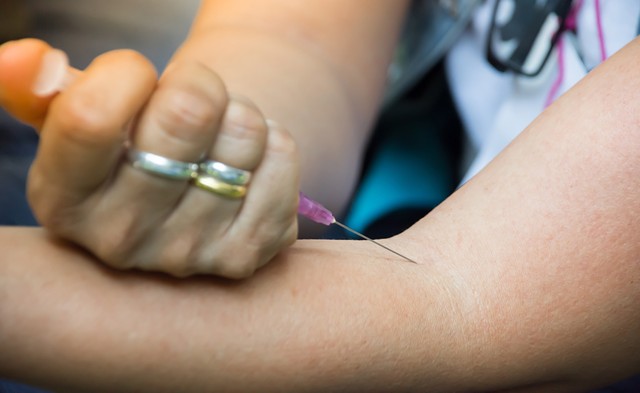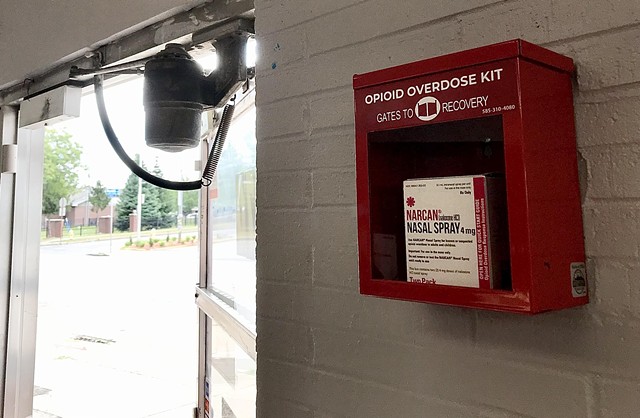As opioid epidemic rages on, supervised injection sites still at a stalemate
By Gino Fanelli @GinoFanelli[
{
"name": "500x250 Ad",
"insertPoint": "5",
"component": "15667920",
"parentWrapperClass": "",
"requiredCountToDisplay": "1"
}
]
Often overlooked during the pandemic has been the nation’s other health crisis: the opioid epidemic.
But more than 95,000 Americans died of drug overdoses over the 12-month period that ended in February, according to the latest federal data available, eclipsing the toll from any year since the opioid epidemic began in the 1990s.
In Monroe County, the overdose death toll climbed to 137 in 2020, an increase over the previous year but short of the all-time annual high reached in 2017.
As public health officials, drug policy experts, recovery advocates, and politicians continue to grope for solutions to stem the toll of opioids, they are increasingly turning their attention to supervised injection sites.
These sites, often called overdose prevention centers by advocates, are locations where people can shoot heroin or any other injectable drug under the watch of a medical professional trained to intervene should something go wrong.
In recent months, elected officials representing Rochester at various levels of state and local government have expressed support for bringing the centers to the city.
“When it comes to opioid abuse and addiction services right now, what we’re doing is not working,” state Sen. Jeremy Cooney said in a recent interview. “Trying something new, even if it’s just a pilot program to collect data in New York, let’s do that instead of sitting on our hands and doing nothing.”
Stances like his have been shaped by the experiences of Canada and Europe, where the sites have long been available, and places like Rhode Island, which recently became the first state to legalize the sites, potentially setting itself up for a showdown in federal court.
Former President Donald Trump’s Department of Justice stymied the creation of supervised injections sites in 2018 when it sued an organization in Philadelphia looking to open a facility. A federal Appeals Court this year ruled that supervised injection sites, while innovative, violate a federal law that makes it a crime to open a property to others to use drugs.
Advocates for the sites were left shaking their heads.
“They’re actually not as controversial as most people think they are,” said Biz Berthy, drug policy campaign coordinator for VOCAL-NY, a grassroots organization that aims to empower low-income people affected by the drug war. “It’s pretty well-known that for over 30 years, overdose prevention centers have worked very successfully across the globe.”
EFFECTIVE OR ENABLING?
Not long ago, it seemed like supervised injection sites were on their way to New York.
In 2018, as Gov. Andrew Cuomo sought re-election, he all but endorsed them in a televised debate.
“The safe injection sites I think are something we should look at,” Cuomo said. “They are very controversial, they are very complicated, the federal government is decidedly against them and could shut them down, but they are something we have the Department of Health working on in concert with New York City.”
A few months earlier, New York City Mayor Bill de Blasio had announced a pilot program to bring four supervised injection sites to his city. Three years on, though, the sites have yet to materialize, in part because of the federal government’s opposition that played out in court.
De Blasio is now reportedly looking to “fast-track” the sites before his term ends this year, and most top mayoral candidates looking to succeed him have said they support opening the centers.
Meanwhile, in August, Rhode Island established a two-year pilot program to test the feasibility of what it called “harm reduction centers,” which would provide medical screenings, drug testing, and a space for people to inject drugs under the watch of medical professionals.
“I think what we’re starting to see is states recognize this is a thing that works,” said Melissa Moore, New York state director of the Drug Policy Alliance. “What we’re seeing in Rhode Island is a shift towards a harm reduction model, and we hope it renews the call for New York exploring that option.”
“Harm reduction” in the United States has been a contentious approach to the war on drugs. The main goal is not to help drug users abstain, but to reduce their risk of dying or acquiring infectious diseases by providing them with sterile equipment and supervision. Distribution of the overdose reversal drug Narcan is another example of harm reduction.
The chief complaint of the strategy has been that it enables drug users, but President Joseph Biden has made expanding harm-reduction efforts one of his drug policy priorities, becoming the first president to do so. Congress specifically set aside $30 million for “evidence-based” harm reduction services.
Supporters of supervised injection sites point to Canada, which opened its first center in Vancouver in 2003. After nearly a decade of political and legal wrangling that culminated in a Canadian Supreme Court ruling favoring the approach, the Canadian government today reports 37 sites across the country.
Calls to 911 for crimes that range from public urination and prostitution to sexual assault and robbery have reportedly risen near the most popular sites in the biggest cities. A study of one unnamed site in Vancouver found that 70 percent of the people who used the facility lived within 1,500 feet of the building.
At the same time, the study suggested the site served its purpose in reducing the number of deaths related to drug overdoses. In that same radius, the risk of overdose death dropped from 253 to 165 per 100,000 residents after the injection site opened. Researchers estimated that one overdose death was prevented for every 1,137 users in the area.
“What I found,” said Berthy, of VOCAL-NY, “is it really boils down to this internalized mindset of the war on drugs, which has also generated a very specific framework to how we approach substance abuse disorders in this country.”
AT A STALEMATE
Two competing bills in Albany offer a clear picture of the stalemate over the issue of injection sites in New York.
One bill, dubbed the “Overdose Prevention Centers Act,” which would allow for the establishment of the sites, has been introduced by Democratic Sen. Gustavo Rivera of the Bronx.
Another bill, supported by state Sen. Fred Akshar, a Republican who represents Binghamton and Southern Tier counties, would ban the sites from ever getting off the ground.
Both bills are stuck in committee.
Cooney, the Rochester state senator who favors the sites, cast the political will for injection centers as growing, but lagging.
He pointed to a bill he co-sponsored to decriminalize the sale of hypodermic needles that passed the Assembly and Senate but has yet to be signed into law as an example of how slow New York is to move on such matters.
“That’s where we are as a policy-making body, we just legalized the ability for someone to go into a drug store and purchase a syringe,” Cooney said. “We’ve got a long way to go on the political will spectrum.”
Some supporters of injection sites have attempted to make them more palatable by suggesting they could be paid for by the $1.1 billion settlement the state negotiated to resolve claims against opioid manufacturers.
Assemblymember Demond Meeks, a Democrat from Rochester, floated the idea at a news conference in July, saying the 137 overdose deaths last year didn’t have to happen.
“That’s totally unacceptable,” he said, “and it’s something we can prevent.”
The Monroe County Heroin Task Force was formed in 2018 to provide a coordinated law enforcement response to the opioid epidemic locally. Task force data show the crisis remains in full swing.
Overdose deaths rose steadily and peaked at 220 in 2017, but fell substantially before bouncing back last year. The 91 overdose deaths in the county this year through August, the last month for which data was available, put the county on pace to match last year’s count.
Mike Favata, a Monroe County Sheriff’s deputy on the task force, said the pandemic exacerbated the problem.
“We have people that have completely changed their lifestyle from when they were actively using, and now we’ve shut them off from that, they can no longer go to work, they can no longer go to the gym, they can no longer have that outlet they had prior to COVID,” Favata said. “With that being said, they reverted right back to their old habits.”
He credits Narcan, the brand name for the nasal inhalant overdose antidote naloxone, with preventing deaths. But he does not support supervised injection sites.
“Normalizing drug use, normalizing and giving people who potentially want help a safe place to do something, they might think, ‘You know what, if I can go in here and do something without the risk of dying, why would I want to stop?’” Favata said. “That’s what we’re trying to do, we’re trying to prevent it.”
Gino Fanelli is a CITY staff writer. He can be reached at (585) 775-9692 or [email protected].
But more than 95,000 Americans died of drug overdoses over the 12-month period that ended in February, according to the latest federal data available, eclipsing the toll from any year since the opioid epidemic began in the 1990s.
In Monroe County, the overdose death toll climbed to 137 in 2020, an increase over the previous year but short of the all-time annual high reached in 2017.
As public health officials, drug policy experts, recovery advocates, and politicians continue to grope for solutions to stem the toll of opioids, they are increasingly turning their attention to supervised injection sites.
These sites, often called overdose prevention centers by advocates, are locations where people can shoot heroin or any other injectable drug under the watch of a medical professional trained to intervene should something go wrong.
In recent months, elected officials representing Rochester at various levels of state and local government have expressed support for bringing the centers to the city.
“When it comes to opioid abuse and addiction services right now, what we’re doing is not working,” state Sen. Jeremy Cooney said in a recent interview. “Trying something new, even if it’s just a pilot program to collect data in New York, let’s do that instead of sitting on our hands and doing nothing.”
Stances like his have been shaped by the experiences of Canada and Europe, where the sites have long been available, and places like Rhode Island, which recently became the first state to legalize the sites, potentially setting itself up for a showdown in federal court.
Former President Donald Trump’s Department of Justice stymied the creation of supervised injections sites in 2018 when it sued an organization in Philadelphia looking to open a facility. A federal Appeals Court this year ruled that supervised injection sites, while innovative, violate a federal law that makes it a crime to open a property to others to use drugs.
Advocates for the sites were left shaking their heads.
“They’re actually not as controversial as most people think they are,” said Biz Berthy, drug policy campaign coordinator for VOCAL-NY, a grassroots organization that aims to empower low-income people affected by the drug war. “It’s pretty well-known that for over 30 years, overdose prevention centers have worked very successfully across the globe.”
EFFECTIVE OR ENABLING?
Not long ago, it seemed like supervised injection sites were on their way to New York.
In 2018, as Gov. Andrew Cuomo sought re-election, he all but endorsed them in a televised debate.
“The safe injection sites I think are something we should look at,” Cuomo said. “They are very controversial, they are very complicated, the federal government is decidedly against them and could shut them down, but they are something we have the Department of Health working on in concert with New York City.”
A few months earlier, New York City Mayor Bill de Blasio had announced a pilot program to bring four supervised injection sites to his city. Three years on, though, the sites have yet to materialize, in part because of the federal government’s opposition that played out in court.
De Blasio is now reportedly looking to “fast-track” the sites before his term ends this year, and most top mayoral candidates looking to succeed him have said they support opening the centers.
Meanwhile, in August, Rhode Island established a two-year pilot program to test the feasibility of what it called “harm reduction centers,” which would provide medical screenings, drug testing, and a space for people to inject drugs under the watch of medical professionals.
“I think what we’re starting to see is states recognize this is a thing that works,” said Melissa Moore, New York state director of the Drug Policy Alliance. “What we’re seeing in Rhode Island is a shift towards a harm reduction model, and we hope it renews the call for New York exploring that option.”
“Harm reduction” in the United States has been a contentious approach to the war on drugs. The main goal is not to help drug users abstain, but to reduce their risk of dying or acquiring infectious diseases by providing them with sterile equipment and supervision. Distribution of the overdose reversal drug Narcan is another example of harm reduction.
The chief complaint of the strategy has been that it enables drug users, but President Joseph Biden has made expanding harm-reduction efforts one of his drug policy priorities, becoming the first president to do so. Congress specifically set aside $30 million for “evidence-based” harm reduction services.
Supporters of supervised injection sites point to Canada, which opened its first center in Vancouver in 2003. After nearly a decade of political and legal wrangling that culminated in a Canadian Supreme Court ruling favoring the approach, the Canadian government today reports 37 sites across the country.
Calls to 911 for crimes that range from public urination and prostitution to sexual assault and robbery have reportedly risen near the most popular sites in the biggest cities. A study of one unnamed site in Vancouver found that 70 percent of the people who used the facility lived within 1,500 feet of the building.
At the same time, the study suggested the site served its purpose in reducing the number of deaths related to drug overdoses. In that same radius, the risk of overdose death dropped from 253 to 165 per 100,000 residents after the injection site opened. Researchers estimated that one overdose death was prevented for every 1,137 users in the area.
“What I found,” said Berthy, of VOCAL-NY, “is it really boils down to this internalized mindset of the war on drugs, which has also generated a very specific framework to how we approach substance abuse disorders in this country.”
AT A STALEMATE
Two competing bills in Albany offer a clear picture of the stalemate over the issue of injection sites in New York.
One bill, dubbed the “Overdose Prevention Centers Act,” which would allow for the establishment of the sites, has been introduced by Democratic Sen. Gustavo Rivera of the Bronx.
Another bill, supported by state Sen. Fred Akshar, a Republican who represents Binghamton and Southern Tier counties, would ban the sites from ever getting off the ground.
Both bills are stuck in committee.
Cooney, the Rochester state senator who favors the sites, cast the political will for injection centers as growing, but lagging.
He pointed to a bill he co-sponsored to decriminalize the sale of hypodermic needles that passed the Assembly and Senate but has yet to be signed into law as an example of how slow New York is to move on such matters.
“That’s where we are as a policy-making body, we just legalized the ability for someone to go into a drug store and purchase a syringe,” Cooney said. “We’ve got a long way to go on the political will spectrum.”
Some supporters of injection sites have attempted to make them more palatable by suggesting they could be paid for by the $1.1 billion settlement the state negotiated to resolve claims against opioid manufacturers.
Assemblymember Demond Meeks, a Democrat from Rochester, floated the idea at a news conference in July, saying the 137 overdose deaths last year didn’t have to happen.
“That’s totally unacceptable,” he said, “and it’s something we can prevent.”
The Monroe County Heroin Task Force was formed in 2018 to provide a coordinated law enforcement response to the opioid epidemic locally. Task force data show the crisis remains in full swing.
Overdose deaths rose steadily and peaked at 220 in 2017, but fell substantially before bouncing back last year. The 91 overdose deaths in the county this year through August, the last month for which data was available, put the county on pace to match last year’s count.
Mike Favata, a Monroe County Sheriff’s deputy on the task force, said the pandemic exacerbated the problem.
“We have people that have completely changed their lifestyle from when they were actively using, and now we’ve shut them off from that, they can no longer go to work, they can no longer go to the gym, they can no longer have that outlet they had prior to COVID,” Favata said. “With that being said, they reverted right back to their old habits.”
He credits Narcan, the brand name for the nasal inhalant overdose antidote naloxone, with preventing deaths. But he does not support supervised injection sites.
“Normalizing drug use, normalizing and giving people who potentially want help a safe place to do something, they might think, ‘You know what, if I can go in here and do something without the risk of dying, why would I want to stop?’” Favata said. “That’s what we’re trying to do, we’re trying to prevent it.”
Gino Fanelli is a CITY staff writer. He can be reached at (585) 775-9692 or [email protected].
Latest in News
More by Gino Fanelli
-

DeWolf Brewing Company set to open in Victor
Apr 26, 2024 -

These small cannabis farmers say New York's legal weed rollout is ruining their lives
Mar 21, 2024 -

Man shakes fist at sun
Mar 15, 2024 - More »









